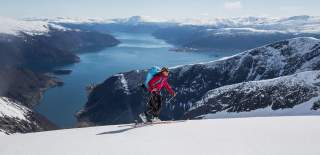Ski Touring Sognefjord
Skiing with the Best Fjord View in the World
- in the Best Snow
Exploring majestic landscapes, trekking through unbroken snow, breathing in fresh mountain air. The Sognefjord invites you to amazing free skiing nature, as from the mountain top to the fjord. The mountains of Sognefjord are perfect for ski touring and backcountry skiing. There are an immense number of peaks to choose from, suitable for the experienced skier or for the beginner. You will find experienced guides that take you to the best snow, and offer guiding and courses for all levels.
Explore mountains and fjords, all with gorgeous views. Make thrilling descents to the shoreline or explore remote and frozen valleys and hidden lines deep into the mountains of the Sognefjord.
Backcountry skiing takes you where hiking and regular transport cannot in this pristine region.
Norway and the Sognefjord regio is chock-full of incredibly beautiful scenery, to which a layer of magic and mystery is added with the winter snows. Backcountry skiing is an incredible way to explore the mountains, fjords and glaciers of this incredible country and see the kinds of things that are rarely found elsewhere.
Here in Norway you have to 'earn your turns', as they say in the ski touring community. There are no helicopters that take you to the top.
Something for everyone
For beginners and experts alike, Norway and Sognefjord has plenty to offer.
For those getting into the backcountry for the first time, the modest slopes is the perfect place to get your bearings. On the other hand, the harsh terrain of Norway are perfect for advanced backcountry enthusiasts looking to test their mettle.
A good place to start is in the Sognefjord area.
One of the reasons the Sognefjord region is so popular is that you get the sea to summit experience. We’re talking winter views of the epic fjords!
You can also join pre-packaged tours.
The peak season for alpine ski touring is between March and June. But the ski touring season stretches from December to June in the Sognefjord region. The Sognefjord region usually got a more stabile climate and temperature than more coastal areas. In that matter of case, the snow would lay longer.
Any trip to Norway and Sognefjord likely begins with a flight into Oslo Airport (OSL). From here, you can take a connecting flight or a bus, maybe rent a car.
You find surreal beauty, natural elements at their chore where the fjord, mountains and skies confound.
The mountains are calling!
Touring equipment
You can either bring your own equipment or everything you need. As a minimum, you'll need the following:
Alpine skis with walking mode – big skis in the winter and smaller, more lightweight ones in spring and summer
- Good lightweight boots with walking mode
- Skins for the skis and adjustable poles
- A small backpack (30L) with avalanche beacon, shovel and search probe
- Good warm clothing, sunglasses, sunscreen and of course a camera
While renting equipment is easy, we do recommend bringing your own shoes. Good, comfortable shoes are the key to a great skiing experience in Sognefjord!
Read more about safety, changing conditions, what to bring and what to wear.
Safety first
The rule is simple: don’t go ski touring by yourself if you don't have any experience. Join a tour with guides that help you find the right equipment and show you how to use it and where to go safe in the terrain. They will also choose routes based on your skills, the weather conditions, and avalanche risks.
To ensure a safe and enjoyable experience, you also have to be in a good physical shape and have experience from downhill skiing in varied and difficult terrain.
Avalanche safety
Each year, avalanches in Norwegian mountains kill an average of five people, most of whom are ski tourers. Foreign visitors make up a disproportionately large share.
Stay safe by following these rules:
1. Take a course to learn more about avalanches, avalanche terrain, and avalanche hazard ratings, even if you are not planning on travel through avalanche terrain.
2. Be aware that you can be caught in an avalanche on flat terrain. An avalanche can run three times the vertical drop from fracture line.
3. We strongly recommend the use of a local ski guide, both for your safety and for assuring a better and more interesting experience.
4. Start planning your trip at the avalanche forecast site varsom.no.
5. Download the Varsom app from App store or Android store. With Varsom, you can share and access information about local conditions, and download offline maps.
6. Stay updated on the weather conditions in your area with yr.no and senorge.no.
7. Always bring an avalanche transceiver, a probe and a shovel when you are in avalanche terrain. And know how to use it!

